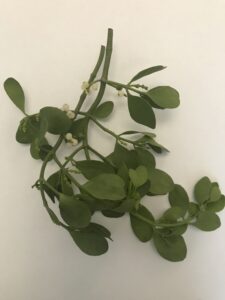What Is Mistletoe?
go.ncsu.edu/readext?837392
en Español / em Português
El inglés es el idioma de control de esta página. En la medida en que haya algún conflicto entre la traducción al inglés y la traducción, el inglés prevalece.
Al hacer clic en el enlace de traducción se activa un servicio de traducción gratuito para convertir la página al español. Al igual que con cualquier traducción por Internet, la conversión no es sensible al contexto y puede que no traduzca el texto en su significado original. NC State Extension no garantiza la exactitud del texto traducido. Por favor, tenga en cuenta que algunas aplicaciones y/o servicios pueden no funcionar como se espera cuando se traducen.
Português
Inglês é o idioma de controle desta página. Na medida que haja algum conflito entre o texto original em Inglês e a tradução, o Inglês prevalece.
Ao clicar no link de tradução, um serviço gratuito de tradução será ativado para converter a página para o Português. Como em qualquer tradução pela internet, a conversão não é sensivel ao contexto e pode não ocorrer a tradução para o significado orginal. O serviço de Extensão da Carolina do Norte (NC State Extension) não garante a exatidão do texto traduzido. Por favor, observe que algumas funções ou serviços podem não funcionar como esperado após a tradução.
English
English is the controlling language of this page. To the extent there is any conflict between the English text and the translation, English controls.
Clicking on the translation link activates a free translation service to convert the page to Spanish. As with any Internet translation, the conversion is not context-sensitive and may not translate the text to its original meaning. NC State Extension does not guarantee the accuracy of the translated text. Please note that some applications and/or services may not function as expected when translated.
Collapse ▲ With the Christmas season upon us, it is time to finish decorating homes and continue traditions that have been passed from generation to generation. One tradition that is very popular during the Christmas season is that of kissing underneath the mistletoe. Mistletoe is a symbol of life, love, and even fertility. However, have you ever stopped to think what mistletoe is and where it comes from?
With the Christmas season upon us, it is time to finish decorating homes and continue traditions that have been passed from generation to generation. One tradition that is very popular during the Christmas season is that of kissing underneath the mistletoe. Mistletoe is a symbol of life, love, and even fertility. However, have you ever stopped to think what mistletoe is and where it comes from?
Mistletoe is an evergreen that grows out of tree limbs. It is hidden by tree leaves for most of the year but balls of mistletoe become very apparent after leaves have fallen in late fall. Mistletoe is a hemi-parasitic plant that grows out of many tree species. Unlike fully parasitic plants, mistletoe has the ability to make its own energy stores which it takes up through photosynthesis. Mistletoe does, however, rely on its tree host for water and other nutrients. To get the nutrients it needs from its tree host, and to cling to the tree, mistletoe uses specialized roots called haustoria which penetrate the tree tissues and hold it in place.
As mistletoe is hemi-parasitic, it can weaken trees by siphoning off water and other nutrients. Most trees can withstand these mistletoe freeloaders without any negative effects. However, trees that have large numbers of mistletoe plants within them, or trees that are stressed from other factors, will weaken over time. If your tree is weak and you are afraid that mistletoe will be the straw that breaks the camel’s back, it may be time to remove mistletoe. To properly remove mistletoe, you must prune out the branch that it has been colonized to the point where you remove all visible shoots and the largely invisible mistletoe roots. Simply removing mistletoe shoots from the tree branch will leave the roots which can re-sprout, just like weeds in the garden. It is, however, unnecessary to remove mistletoe from every tree in sight as that mistletoe is an important part of the ecosystem.
Mistletoe relies on birds and mammals to spread from one location to another. Animals eat the white berries of mistletoe and later excrete those seeds while they are up in trees. While birds are the most common animal taking advantage of the berries, there are many other animals and insects that use mistletoe. Birds will nest within the mistletoe, bees use nectar from mistletoe flowers, and the great purple hairstreak butterfly relies on mistletoe for its larvae’s sole food source. Most mistletoe is found high in trees where birds rest or roost after eating mistletoe berries. Getting this mistletoe out of trees can be very challenging and has become a tradition in itself.
There are many species of mistletoe that live on different species of trees and inhabit varied regions of the United States and world. While there are many species, North American mistletoe is broken down into two main groups. Dwarf mistletoes are largely leafless and tend to colonize species of pine, firs, and other conifers. Dwarf mistletoe is in the genus Aurceuthobium and is generally not used for our holiday traditions. The leafy American mistletoe species are within the genus Phoradendron and tend to colonize many deciduous tree species such as oaks, maples, ash, hickory, and elms. Phoradendron leucarpum is the mistletoe species found in the southeast and can make beautiful Christmas decorations.
Similar to poinsettia, mistletoe leaves and berries are mildly toxic if ingested. Mistletoe clippings from the yard and mistletoe decorations should be kept away from curious children and pets. If ingestion occurs, contact a poison center helpline immediately.



